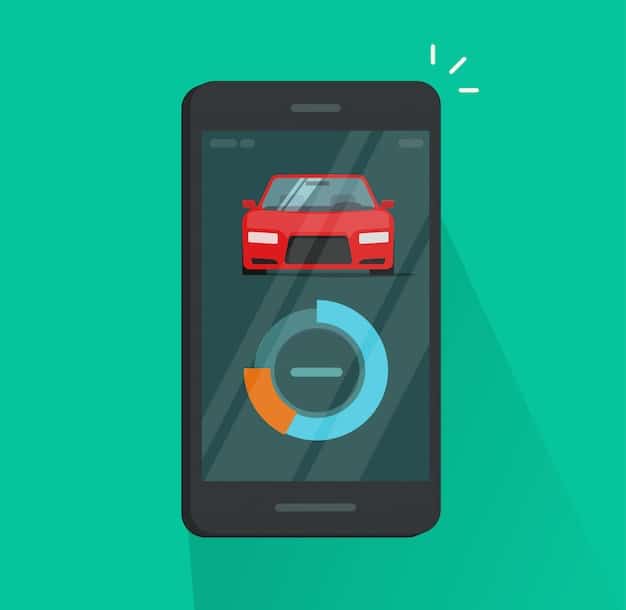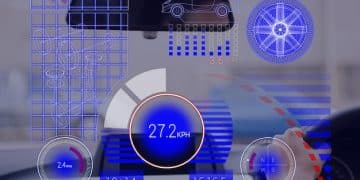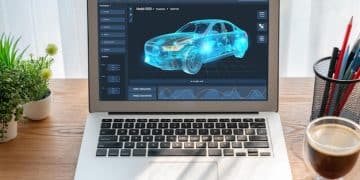Automotive Cybersecurity Trends: What’s Next in the US?

The key trends shaping the future of automotive cybersecurity in the US include advancements in AI-driven security, increased focus on over-the-air (OTA) updates, regulatory compliance, enhanced threat intelligence sharing, and the integration of blockchain technology for secure data management.
The automotive industry in the US is undergoing a rapid transformation, with cybersecurity becoming a critical concern. As vehicles become more connected and autonomous, the need for robust cybersecurity measures intensifies. Let’s explore the key trends shaping the future of automotive cybersecurity in the US.
The Rise of Connected Vehicles and Cybersecurity Risks
Connected vehicles offer numerous benefits, including enhanced navigation, entertainment, and vehicle management. However, this connectivity also introduces significant cybersecurity risks. Understanding these risks is the first step towards building a secure automotive ecosystem.
The increasing reliance on software and network connectivity makes vehicles vulnerable to various cyber threats, ranging from data breaches to remote vehicle control. Automotive cybersecurity must address these evolving threats to ensure the safety and security of drivers and passengers.
Potential Cyber Threats to Connected Vehicles
Connected vehicles face a wide range of potential cyber threats. These threats can compromise vehicle systems, personal data, and even physical safety. Identifying these threats is crucial for developing effective cybersecurity strategies.
- Malware Infections: Cybercriminals can introduce malware into vehicle systems, disrupting functionality and compromising data.
- Data Breaches: Connected vehicles collect vast amounts of personal data, which can be targeted by hackers for identity theft and fraud.
- Remote Vehicle Control: Hackers can remotely control vehicle functions, such as steering, braking, and acceleration, posing a significant safety risk.
- Denial of Service (DoS) Attacks: These attacks can disrupt vehicle connectivity and prevent drivers from accessing critical services.
Mitigating these risks requires a multi-layered approach, including robust security protocols, intrusion detection systems, and regular software updates. The automotive industry must prioritize cybersecurity to protect against these evolving threats and ensure the safety and security of connected vehicles.
In summary, the rise of connected vehicles has introduced new cybersecurity challenges that must be addressed proactively. By understanding the potential threats and implementing robust security measures, the automotive industry can ensure the safety and security of drivers and passengers in the connected era.

AI-Driven Security Solutions
Artificial intelligence (AI) is revolutionizing automotive cybersecurity by providing advanced threat detection and prevention capabilities, to protect increasingly complex vehicular ecosystems.
Traditional security measures often struggle to keep pace with evolving cyber threats, but AI-driven security solutions can analyze vast amounts of data in real-time to identify and respond to potential attacks. These AI systems learn from past attacks and adapt to new threats, providing robust protection for connected vehicles.
Benefits of AI in Automotive Cybersecurity
AI offers numerous benefits for automotive cybersecurity, including enhanced threat detection, automated incident response, and improved security efficiency. These capabilities are essential for protecting connected vehicles against increasingly sophisticated cyber threats.
- Real-time Threat Detection: AI algorithms can analyze vehicle data in real-time to detect anomalies and potential cyber threats.
- Automated Incident Response: AI systems can automatically respond to detected threats, isolating compromised systems and preventing further damage.
- Predictive Security: AI can predict future cyber threats based on historical data and emerging attack patterns.
- Enhanced Security Efficiency: AI can automate many security tasks, freeing up human resources to focus on more complex security challenges.
Implementing AI-driven security requires careful planning and execution. Automakers must invest in advanced AI technologies, train cybersecurity professionals, and establish robust data management practices to ensure the effectiveness of these solutions.
In conclusion, AI-driven security solutions are transforming automotive cybersecurity, providing advanced threat detection and prevention capabilities. By leveraging the power of AI, the automotive industry can protect connected vehicles against evolving cyber threats and ensure the safety and security of drivers and passengers.
Over-the-Air (OTA) Updates and Security Patches
Over-the-air (OTA) updates are becoming increasingly important for automotive cybersecurity. OTA updates enable automakers to remotely deploy security patches and software updates, addressing vulnerabilities and improving vehicle security. This ability is crucial for maintaining the security of connected vehicles throughout their lifecycle.
Traditionally, vehicle software updates required physical visits to dealerships, which could be inconvenient and time-consuming. OTA updates eliminate this need, allowing automakers to remotely deploy updates and ensure vehicles are always running the latest security software.

The Role of OTA Updates in Cybersecurity
OTA updates play a critical role in automotive cybersecurity by enabling automakers to quickly address vulnerabilities and deploy security patches. This capability is essential for protecting connected vehicles against evolving cyber threats and ensuring the safety and security of drivers and passengers.
Effective OTA update management requires robust security protocols to prevent unauthorized updates and ensure the integrity of the software. Automakers must implement strong authentication and encryption measures to protect against malicious attacks and ensure that only authorized updates are deployed to vehicles.
Moreover, OTA update strategies must address potential risks associated with update failures. Automakers need to implement fallback mechanisms to ensure that vehicles can recover from failed updates and prevent disruptions to vehicle functionality. This includes testing updates thoroughly before deployment and providing clear communication to drivers about the update process.
In summary, OTA updates are a critical component of automotive cybersecurity, enabling automakers to remotely deploy security patches and software updates. By implementing robust security protocols and addressing potential risks, the automotive industry can leverage OTA updates to enhance vehicle security and protect against evolving cyber threats.
Regulatory Compliance and Standards
Regulatory compliance and industry standards are playing an increasingly important role in shaping the future of automotive cybersecurity in the US. Government regulations and industry standards provide a framework for automakers to develop and implement robust cybersecurity measures, ensuring the safety and security of connected vehicles. A uniform cybersecurity landscape, especially within the US is critical in ensuring best practices are followed and potential risks are mitigated.
These regulatory frameworks aim to address the unique cybersecurity challenges posed by connected vehicles, encouraging automakers to prioritize security throughout the vehicle lifecycle. Automakers are working to meet these regulatory compliances and standards to safeguard the interests of the nation.
Key Regulatory Frameworks and Standards
Several key regulatory frameworks and standards are shaping automotive cybersecurity in the US. These include federal regulations, industry standards, and voluntary guidelines.
- NHTSA Guidelines: The National Highway Traffic Safety Administration (NHTSA) has issued guidelines for automotive cybersecurity, providing recommendations for automakers to enhance vehicle security.
- SAE Standards: The Society of Automotive Engineers (SAE) has developed standards for automotive cybersecurity, including SAE J3061, which provides a framework for cybersecurity engineering.
- ISO/SAE 21434: This international standard provides requirements for cybersecurity risk management in the automotive industry.
Compliance with these regulatory frameworks and standards requires automakers to implement robust cybersecurity measures, including vulnerability assessments, penetration testing, and incident response planning. Automakers must also establish processes for monitoring and updating vehicle software to address emerging cyber threats.
In response, Automakers are investing in cybersecurity expertise and technologies to ensure compliance with regulatory requirements. This includes hiring cybersecurity professionals, implementing secure development practices, and establishing partnerships with cybersecurity firms. The focus is to ensure they don’t fail these regulations.
In summary, regulatory compliance and industry standards are essential for ensuring the safety and security of connected vehicles in the US. By adhering to these frameworks, automakers can demonstrate their commitment to cybersecurity and protect against evolving cyber threats.
Threat Intelligence Sharing and Collaboration
Threat intelligence sharing and collaboration are becoming increasingly important for automotive cybersecurity. Sharing threat intelligence among automakers, suppliers, and cybersecurity firms enables the industry to proactively identify and respond to emerging cyber threats to create a collaborative and secure ecosystem.
By working together, organizations can leverage collective knowledge and expertise to defend against sophisticated cyber attacks. Threat intelligence sharing enables the timely dissemination of information about emerging threats, vulnerabilities, and attack patterns, allowing organizations to take proactive measures to protect their systems.
Benefits of Threat Intelligence Sharing
Sharing threat intelligence offers numerous benefits for automotive cybersecurity, including improved threat detection, faster incident response, and enhanced security collaboration. These benefits are essential for protecting connected vehicles against evolving cyber threats and safeguarding the safety and security of drivers and passengers.
- Improved Threat Detection: Sharing threat intelligence enables organizations to identify and detect cyber threats more quickly and accurately.
- Faster Incident Response: Sharing threat intelligence facilitates faster incident response by providing timely information about ongoing attacks and effective mitigation strategies.
- Enhanced Security Collaboration: Sharing threat intelligence fosters collaboration among organizations, enabling them to work together to defend against cyber threats.
Effective threat intelligence sharing requires establishing trusted relationships among participants and implementing secure communication channels. Organizations must also develop processes for sanitizing and anonymizing threat intelligence data to protect sensitive information and ensure compliance with privacy regulations.
In addition, fostering the culture of collaboration is critical; automakers are actively participating in industry consortia and information-sharing platforms to exchange threat intelligence data. These platforms provide a secure and trusted environment for sharing threat intelligence, facilitating collaboration, and enhancing the overall security posture of the automotive industry.
In summary, threat intelligence sharing and collaboration are essential for proactive automotive cybersecurity. By working together, the automotive industry can effectively defend against evolving cyber threats and ensure the safety and security of connected vehicles.
Blockchain Technology for Secure Data Management
Blockchain technology is emerging as a promising solution for secure data management in automotive cybersecurity. Blockchain provides a decentralized, immutable, and transparent ledger for recording and verifying data transactions. This capability can be leveraged to enhance the security and integrity of vehicle data. Here we will see Blockchain integrated and managed securely within the vehicle computer systems.
By leveraging blockchain, automakers can ensure the authenticity and integrity of vehicle data, preventing tampering and unauthorized access. Blockchain tech can be used to secure vehicle software updates, manage digital identities, and track vehicle provenance. As such, Blockchain provides cutting edge ways to manage data.
Applications of Blockchain in Automotive Cybersecurity
Blockchain has numerous applications in automotive cybersecurity, including secure software updates, digital identity management, and vehicle provenance tracking. These applications can enhance the security and transparency of vehicle data, reducing the risk of cyber attacks and fraud.
- Secure Software Updates: Blockchain can be used to verify the authenticity and integrity of vehicle software updates, preventing malicious updates from being deployed.
- Digital Identity Management: Blockchain can provide a secure and decentralized platform for managing digital identities, enabling secure access to vehicle systems and services.
- Vehicle Provenance Tracking: Blockchain can be used to track the provenance of vehicles, providing a transparent and immutable record of vehicle history.
Implementing blockchain technology requires careful planning and execution. Automakers must consider the scalability, performance, and security requirements of their applications and select appropriate blockchain platforms and protocols. This is due in part to the sheer volume of data that blockchain can process.
With blockchain gaining momentum the automotive industry is exploring pilot projects to test blockchain and also assess its feasibility in various areas such as supply chain management, vehicle data sharing, and cybersecurity. These pilot projects provide valuable insights and learnings, facilitating the adoption of blockchain technology in the automotive sector.
In summary, blockchain technology offers a promising solution for secure data management in automotive cybersecurity. By leveraging blockchain, automakers can enhance the security and transparency of vehicle data, reducing the risk of cyber attacks and fraud.
| Key Trend | Brief Description |
|---|---|
| 🤖 AI-Driven Security | AI enhances threat detection and incident response in real-time. |
| 📡 OTA Updates | Remote deployment of security patches and software updates for vehicles. |
| 🛡️ Regulatory Compliance | Adherence to frameworks like NHTSA guidelines and SAE standards. |
| 🤝 Threat Sharing | Collaboration and intelligence sharing among automakers and firms. |
FAQ
▼
Connected cars are vulnerable to malware, data breaches, remote control attacks, and DDoS attacks, which can compromise vehicle systems and driver safety. Enhanced security measures are urgently needed.
▼
AI can analyze vehicle data in real-time to detect anomalies, automate incident responses, and predict future cyber threats, enhancing overall security. AI solutions also promote efficiency to security efforts.
▼
OTA updates allow automakers to remotely deploy security patches and software updates, addressing vulnerabilities quickly without requiring visits to dealerships; timely fixes are thus available.
▼
Standards like NHTSA guidelines and SAE standards provide a framework for automakers to implement robust cybersecurity measures, ensuring vehicle safety and compliance. The US automotive system benefits as a whole.
▼
Blockchain provides a decentralized and immutable ledger for verifying vehicle data, securing software updates, and managing digital identities, reducing the risk of tampering and fraud.
Conclusion
As the automotive industry evolves, cybersecurity will continue to be a paramount concern. The trends outlined above—AI-driven security, OTA updates, regulatory compliance, threat intelligence sharing, and blockchain technology—are shaping the future of automotive cybersecurity in the US, ensuring safer and more secure connected vehicles.





